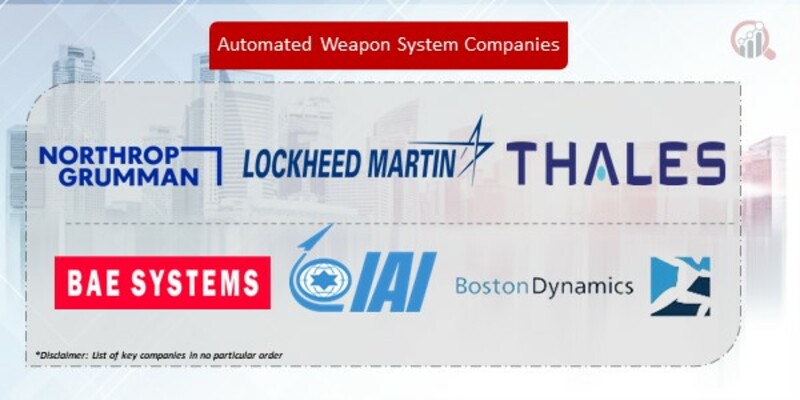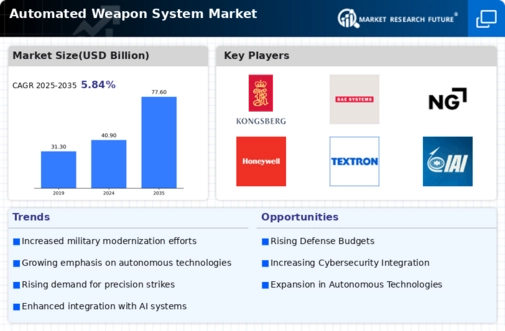Top Industry Leaders in the Automated Weapon System Market

Key players :
Northrop Grumman Corporation (US)
Lockheed Martin Corporation (US)
Thales Group (France)
BAE Systems Plc (UK)
Israel Aerospace Industries Ltd (Israel)
Boston Dynamics (US)
Aerovironment Inc. (US)
Turkish Aerospace Industries Inc. (Turkey)
Saab AB (Sweden)
General Dynamics Corporation (US).
Strategies Adopted
The competitive landscape of the automated weapon system market is dynamic and evolving, reflecting advancements in technology, geopolitical developments, and the constant pursuit of military superiority. Key players in this domain are continually refining their strategies to stay ahead in an environment marked by innovation and strategic alliances. One of the prominent players is Northrop Grumman Corporation, which has positioned itself as a leader through the development of cutting-edge automated weapon systems. The company has focused on leveraging artificial intelligence (AI) and machine learning to enhance the capabilities of its weapons, enabling quicker decision-making and improved accuracy in targeting.
Lockheed Martin Corporation is another major player that has adopted a multifaceted approach to maintain its competitive edge. The company has invested heavily in research and development, aiming to create versatile automated weapon systems capable of addressing a wide range of military challenges. Additionally, Lockheed Martin has formed strategic partnerships with other defense contractors and technology companies to harness collective expertise and resources. These collaborations have enabled the company to offer integrated solutions, combining automated weapon systems with complementary technologies like sensors and communication systems.
Boeing, a key player in the aerospace and defense industry, has also made significant strides in the automated weapon system market. The company's focus lies in the development of unmanned aerial vehicles (UAVs) equipped with advanced weaponry. Boeing's strategy involves catering to the growing demand for autonomous systems, particularly in reconnaissance and surveillance applications. By incorporating AI-driven features into its products, Boeing aims to provide military forces with enhanced situational awareness and mission effectiveness.
As the market continues to evolve, factors for market share analysis become crucial in understanding the competitive landscape. Technological innovation, cost-effectiveness, and the ability to adapt to diverse military requirements are key determinants. Companies investing in research and development to create more sophisticated and adaptable automated weapon systems are likely to gain a competitive advantage. Market penetration strategies, such as offering modular and scalable solutions, also play a pivotal role in capturing a larger share of the market.
Emerging Companies
The emergence of new and innovative companies further contributes to the competitive dynamics of the automated weapon system market. Start-ups specializing in AI, robotics, and autonomous systems have entered the arena, challenging established players. These newcomers often bring fresh perspectives and disruptive technologies, forcing traditional defense contractors to adapt or risk losing market share. Smaller companies with niche expertise may find opportunities in addressing specific military needs, carving out a space for themselves in this highly specialized market.
Industry news reflects the ongoing developments in the automated weapon system market, including contract awards, technological breakthroughs, and geopolitical shifts influencing procurement decisions. For instance, recent news highlights the increasing emphasis on swarming drone technology, where multiple autonomous drones collaborate to achieve mission objectives. This trend signifies a shift towards more decentralized and adaptable systems, influencing the strategies of key market players as they seek to capitalize on this emerging paradigm.
Current company investment trends reveal a growing focus on dual-use technologies that can serve both military and civilian purposes. Companies are exploring applications of automated weapon systems beyond traditional defense, such as border security, disaster response, and surveillance. This diversification strategy not only expands market opportunities but also hedges against potential fluctuations in defense budgets. Investments in cybersecurity to address concerns related to the vulnerability of automated systems to hacking and cyber threats are also on the rise, reflecting the increasing importance of securing these technologies.
Recent News
Lockheed Martin received contract worth up to USD 480 million for the critical design review, testing and production readiness support of the Air-Launched Rapid Response Weapon (ARRW)
Northrop Grumman acquired Orbital ATK and become Northrop Grumman’s fourth business sector, named Northrop Grumman Innovation Systems. The acquisition was valued at USD 7.8 billion.
In November 2017, Raytheon joined with Saab to develop new weapon systems for soldiers operating in critical environments
In June 2017, BAE Systems entered into a collaborative agreement with Leonardo to offer new large caliber precision-guided solutions to the US Military and its allies.










